Can You Freeze Cooked Collard Greens
Yes, you can freeze cooked collard greens, and it's an excellent way to preserve their flavor, texture, and nutritional value for up to six months. To freeze cooked collards, let them cool completely, then store them in airtight containers or freezer-safe bags, removing as much air as possible. Be sure to label the containers with the freezing date. When you're ready to use them, thaw the greens in the refrigerator overnight and reheat them on the stovetop or in the microwave. Remember to heat them thoroughly to an internal temperature of 165°F for food safety. Freezing cooked collards offers convenience and helps you take advantage of seasonal abundance. The following sections will provide more detailed insights into the process.
This post may contain affiliate links. If you make a purchase through these links, I may earn a commission at no additional cost to you. Additionally, portions of this post may be generated using artificial intelligence (AI) technology. While we strive for accuracy, please be aware that AI-generated content may not always be perfect and should be fact-checked when necessary.
The Spatula Scoops
- Cooked collard greens can be frozen for 3-6 months in freezer-safe bags or airtight containers.
- Freezing cooked collards preserves flavor, texture, and nutritional value better than freezing raw greens.
- Store cooked collards with their cooking liquid to maintain moisture and enhance taste when reheated.
- Label containers with the freezing date and remove as much air as possible to prevent freezer burn.
- Thaw frozen cooked collards in the refrigerator overnight and reheat thoroughly before serving.
Benefits of Freezing Collard Greens
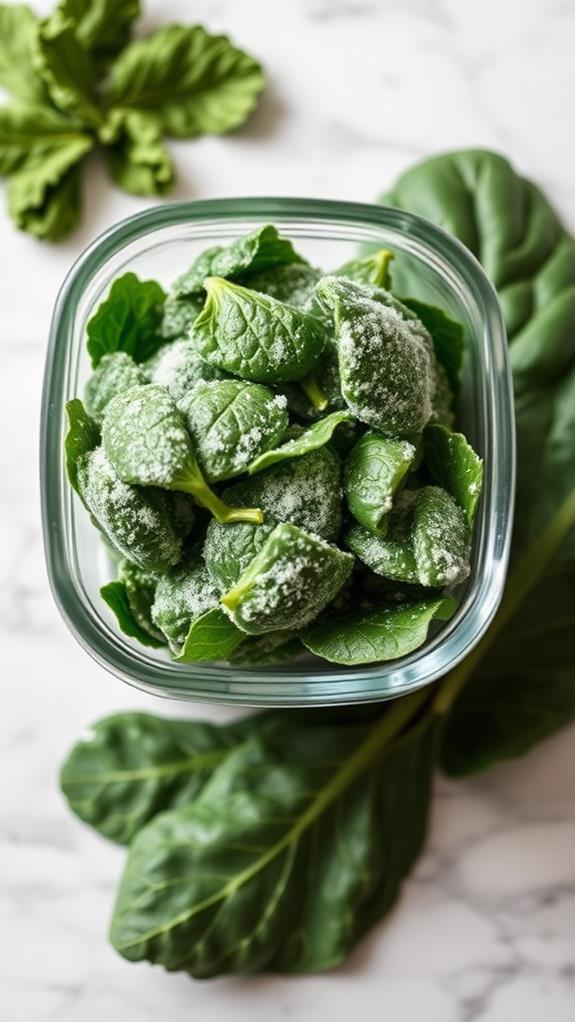
Five key benefits make freezing collard greens a smart choice for home cooks. When you freeze collard greens, you're preserving their flavor, texture, and nutritional value for up to six months. This means you'll have access to high-quality greens long after the growing season has ended. Freezing cooked collard greens is particularly advantageous, as it saves you time in the kitchen. You'll have a convenient source of pre-prepared greens ready to reheat and incorporate into various dishes. Similar to oregano's preservation benefits, freezing collard greens can help maintain their natural flavors and extend their shelf life.
Another benefit is that properly frozen collard greens maintain their vibrant green color and tender-crisp consistency. This guarantees that your meals will look appetizing and taste great, even when using frozen greens. To maximize flavor retention, consider freezing cooked collard greens with their cooking liquid, such as pot likker. This technique helps preserve moisture and enhances the overall taste of the greens.
Lastly, freezing fresh collard greens allows you to take advantage of seasonal abundance or sales. You can stock your freezer with these nutritious greens, ensuring a steady supply throughout the year. By utilizing proper freezing techniques, you'll enjoy the benefits of having delicious, ready-to-use collard greens at your fingertips.
Preparing Collards for Freezing
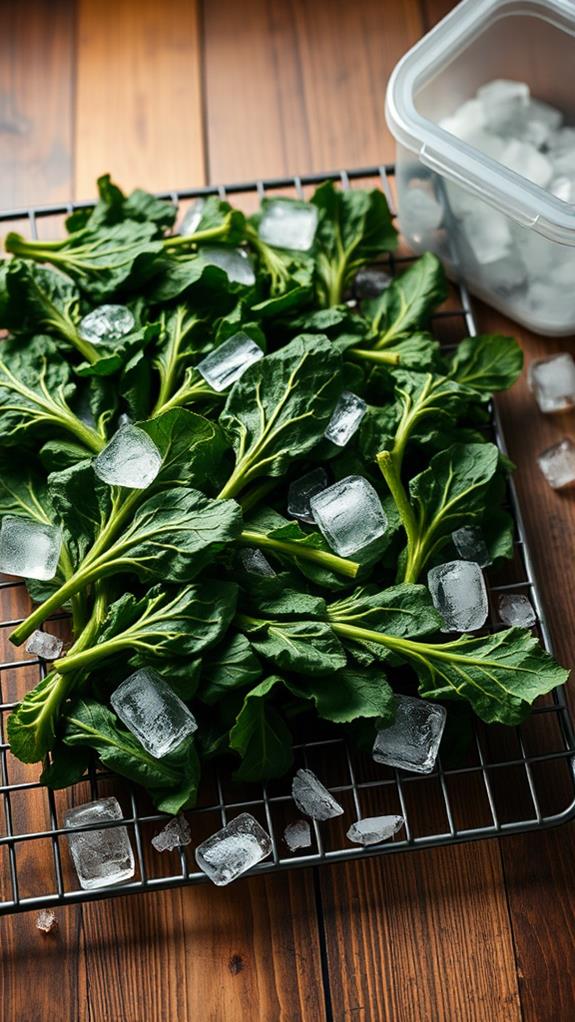
To prepare collard greens for freezing, you'll need to start with proper cleaning and trimming. Wash your greens thoroughly to remove any dirt or debris, then remove the tough stems and cut the leaves into manageable pieces. While collards are generally safe to consume, it's important to handle them carefully, similar to bay leaves in cooking, to guarantee the best culinary experience. Before freezing, it's pivotal to blanch the collards in boiling water for a short time, which helps preserve their color, texture, and nutritional value.
Washing and Trimming Greens
Prior to freezing collard greens, it's indispensable to properly wash and trim them. Start by thoroughly washing your bunch of collard greens in cold water to remove any dirt or debris. You'll want to be thorough, as greens can often harbor hidden grit. Once clean, it's time to trim the leaves. Remove the tough stems and center ribs, as these parts can be fibrous and unpleasant to eat.
Next, you'll need to cut the leaves into manageable pieces. Aim for 1-2 inch strips or smaller chopped pieces, which will make both cooking and freezing easier. After cutting, it's vital to blanch your greens. This process helps preserve their texture and flavor when frozen. To blanch, you'll need a large pot of water. Bring it to a boil and submerge your greens for 3 minutes. Immediately after, plunge them into a bowl of ice water to stop the cooking process. This rapid cooling is vital for maintaining the greens' quality. Once they're cool completely, you can drain and prepare them for freezing.
Blanching Before Freezing
Blanching is a fundamental step in preparing collard greens for freezing. This process helps preserve the flavor, texture, and nutrient content of your greens. To blanch collard greens, you'll need to follow these steps:
- Bring a large pot of water to a rolling boil
- Submerge the collard greens in the boiling water for 3 minutes
- Quickly transfer the greens to an ice water bath to stop the cooking process
The blanching process deactivates enzymes that can lead to quality loss in frozen greens. It's imperative to cool the collards rapidly in ice water to maintain their bright green color and prevent overcooking.
After blanching, you'll need to thoroughly drain and remove excess moisture from the greens. This step is indispensable to prevent freezer burn and off-flavors in your frozen collards. Proper blanching and moisture removal will certify your frozen greens maintain their quality for 8 to 12 months in the freezer.
Freezing Methods for Cooked Collards

Freezing cooked collard greens is a straightforward process that'll help you preserve their flavor and nutrients for future meals. After cooking, allow the greens to cool completely. Then, transfer them to freezer-safe bags or containers, removing as much air as possible. Squeeze out as much excess liquid as you can to prevent ice crystals from forming. Don't forget to include any broth or seasonings used during cooking to maintain the full flavor profile.
Here's a quick guide to freezing and using cooked collards:
| Method | Storage Time | Best Uses |
|---|---|---|
| Freezer Bags | 3-6 months | Soups, stews |
| Airtight Containers | 3-6 months | Side dishes |
| Ice Cube Trays | 2-3 months | Smoothies |
When you're ready to use your frozen greens, simply thaw them in the refrigerator or reheat them directly on the stovetop. You can incorporate these frozen collards into various dishes, such as slow cooker recipes or baked collard green rice. For a quick nutritional boost, blend the frozen greens into a smoothie. Remember to use within the recommended storage time for the best quality and flavor.
Proper Storage Techniques
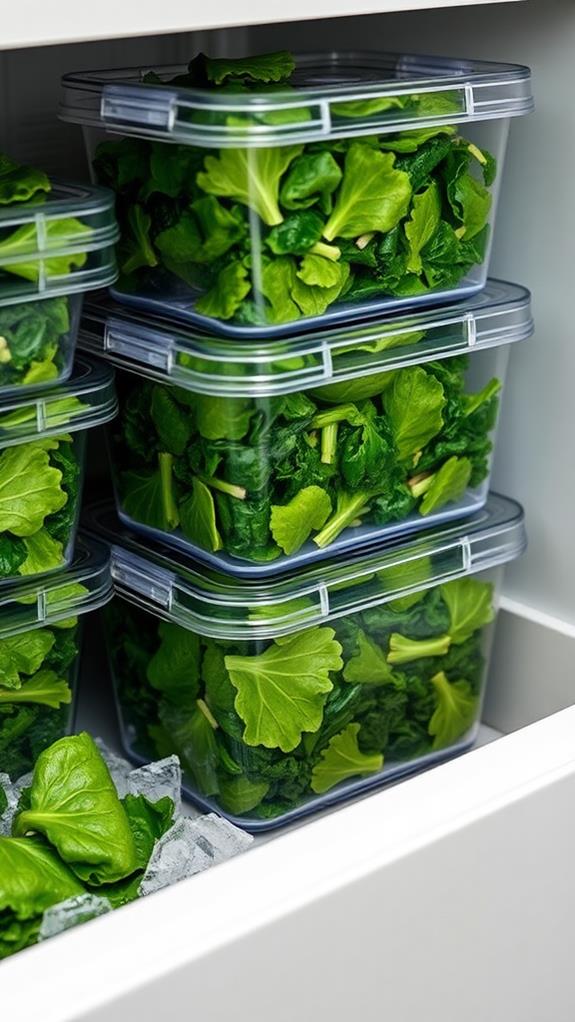
Proper storage techniques are essential for maintaining the quality of your frozen collard greens. When you're ready to freeze them, use airtight containers or freezer-safe bags to store your cooked collards. For ideal results, consider using leak-proof glass containers with BPA-free lids that provide an airtight seal. Don't forget to include any broth or seasonings you've used in cooking, as this will help preserve the original flavor. You'll want to remove as much air as possible from the containers or bags to prevent freezer burn, which can affect the taste and texture of your greens.
- Seal containers tightly, squeezing out excess air
- Label containers with the freezing date
- Use frozen collards within 3 to 6 months for best quality
While you can freeze raw collards, it's generally better to freeze them cooked. If you do freeze raw, use a salad spinner to remove excess moisture first. Remember, you can't freeze them without blanching if you want to maintain their quality. When you're ready to use your frozen collards, thaw them first in the refrigerator. Don't refreeze thawed greens, as this can lead to a loss of texture and flavor. For the longest storage life, consider using vacuum-sealed bags.
Thawing Frozen Collard Greens
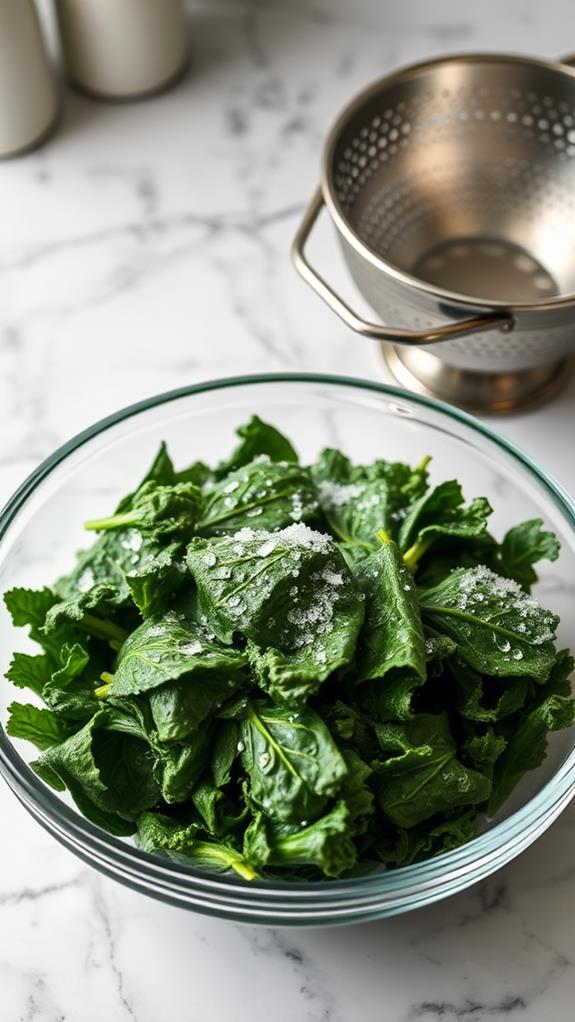
The process of thawing frozen collard greens is straightforward and can be done in several ways. For the best quality, you'll want to thaw your frozen cooked collards in the refrigerator overnight. This slow thawing method helps preserve the texture and flavor of your greens. If you're short on time, you can reheat them directly from their frozen state on the stovetop or in the microwave.
When thawing, it's important to retain the pot likker or cooking liquid to maintain moisture and flavor. You might consider flash freezing your collards on a baking sheet before transferring them to freezer bags, which allows you to portion them into your desired size for easier thawing later. If you need to thaw quickly, you can use cool water, but avoid using too much water as it may dilute the flavor. Remember, once you've thawed your collards, don't refreeze them, as this can negatively impact their texture and taste. Always guarantee you heat your thawed greens thoroughly before serving to ensure food safety. By following these guidelines, you'll be able to enjoy your frozen collards with ideal flavor and texture.
Reheating Frozen Collards
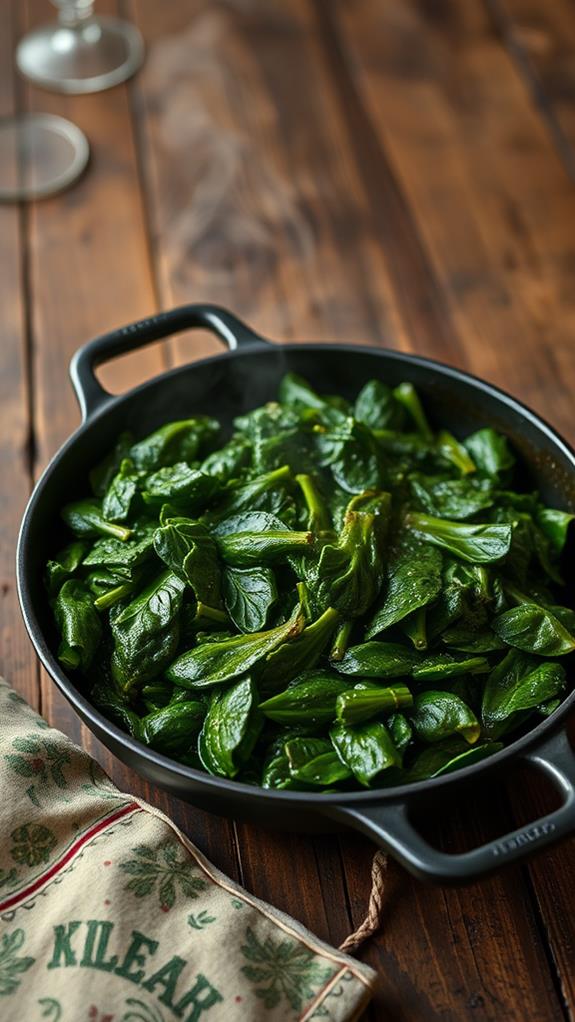
Once you've thawed your collard greens, it's time to reheat them for serving. Whether you've used the refrigerator method or opted to reheat directly from the freezer, guarantee you heat your braised collard greens thoroughly. Use either the stovetop or microwave, and make sure the internal temperature reaches 165°F to eliminate any potential bacteria.
As you reheat your cooked greens, keep these key points in mind:
- Adjust seasoning after reheating to compensate for any texture changes.
- Stir occasionally to guarantee even heating and prevent hot spots.
- Add a splash of water or broth if the greens seem dry.
Recipes Using Frozen Collards
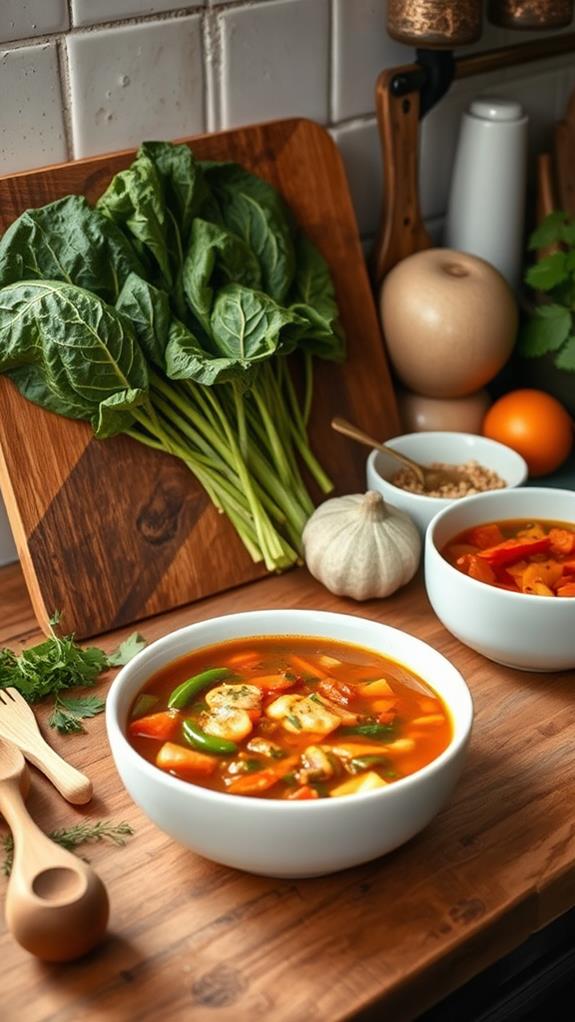
Incorporating frozen collard greens into your recipes is a great way to add nutrition and flavor to various dishes. You'll benefit from the high Vitamin C content and healthy fats like Polyunsaturated Fat and Monounsaturated Fat. For a quick and easy side dish, try sautéing frozen collards with garlic and onions. This method brings out their rich flavor while retaining their nutritional value.
If you're looking for a nutrient-dense breakfast or snack, blend frozen collards into your smoothies. They'll add a boost of vitamins without overpowering the taste. For heartier meals, add frozen cooked collards to soups, stews, or casseroles. This is a great idea for busy weeknights when you need a quick nutrition boost.
For a unique twist, bake frozen collards into cornbread, quiches, or other savory baked goods. You can also incorporate them into rice dishes, such as fried rice or rice bowls. These versatile greens adapt well to various cooking methods, making them an excellent addition to your culinary repertoire. If you found this informative post helpful, consider sharing it or subscribing to our email address for more cooking tips.
Freezing Raw Vs Cooked Collards
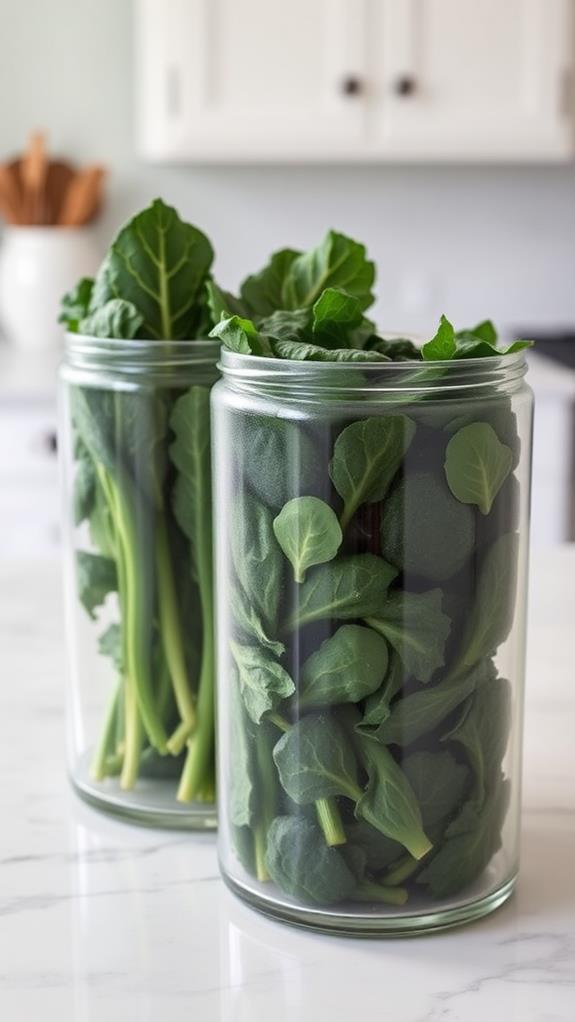
When it comes to freezing collard greens, you have two main options: raw or cooked. Freezing cooked collards is often the preferred method, as it preserves flavor and texture for up to 6 months. You can freeze them with added ingredients like broth or seasonings, making reheating a breeze.
If you're considering freezing raw collards, blanching is indispensable. This process involves:
- Boiling the greens for 3 minutes to stop enzyme activity
- Quickly cooling them in ice water
- Draining and packaging for freezing
Blanching helps retain color, flavor, and nutrients, extending the greens' freezer life to about 3-6 months. Without blanching, raw collards may only last a month before you'll need to throw them away.
When comparing freezing raw vs cooked collards, cooked greens offer more convenience and longevity. They're ready to reheat directly from the freezer, while raw collards require thawing and cooking. However, if you prefer the flexibility of cooking fresh, blanched raw collards are a viable option. Remember, proper storage in airtight containers or bags is essential to prevent freezer burn and maintain quality.
Frequently Asked Questions
What Is the Best Way to Freeze Cooked Collard Greens?
To freeze cooked collard greens effectively, you'll want to start by letting them cool completely. Once cooled, transfer them to freezer-safe bags or containers, making sure to include any broth or cooking ingredients. It's pivotal to remove as much air as possible to prevent freezer burn. Label the containers with the date and contents. For best quality, consume within 3 to 6 months. When you're ready to use them, you can reheat them on the stovetop or add them directly to slow cooker recipes.
How Long Will Cooked Collard Greens Last in the Refrigerator?
Did you know that 60% of food waste occurs at home? To avoid contributing to this statistic, it's vital to know how long your cooked collard greens will last. You can safely store your cooked collard greens in the refrigerator for 3-5 days when kept in an airtight container. If properly stored, they'll maintain their quality and flavor for up to a week. Remember, factors like ingredients, preparation method, and storage conditions can affect their shelf life. Don't leave them at room temperature for more than 2 hours.
How Do You Store Collard Greens After Cooking?
After cooking collard greens, you've got a couple of storage options. For short-term storage, let them cool completely, then transfer them to an airtight container and refrigerate for 3-5 days. For longer storage, you can freeze them. Allow the greens to cool, then place them in freezer-safe bags or containers, including any broth or seasonings. They'll keep in the freezer for 3-6 months. When you're ready to use them, you can reheat frozen collards on the stovetop or in the microwave.
How to Reheat Frozen Collard Greens?
Oh, you've frozen your collard greens? How brave of you to venture into the wild world of vegetable preservation! Now, to reheat them, you've got options. You can simmer them on the stovetop with a splash of broth, microwave them in a dish while stirring occasionally, or use a slow cooker for a few hours. If you're feeling fancy, bake them in the oven at 350°F for about 25 minutes. For best results, thaw them overnight in the fridge before reheating.
Conclusion
You've learned that freezing cooked collard greens is not only possible but also practical. While fresh collards offer vibrant flavor, frozen ones provide convenience. By following proper freezing techniques, you'll preserve nutrients and taste for future meals. Whether you're batch cooking or saving leftovers, frozen collards are a versatile addition to your freezer. Remember, raw collards freeze differently than cooked ones, so choose the method that best suits your needs. With this knowledge, you're ready to enjoy collards year-round.





